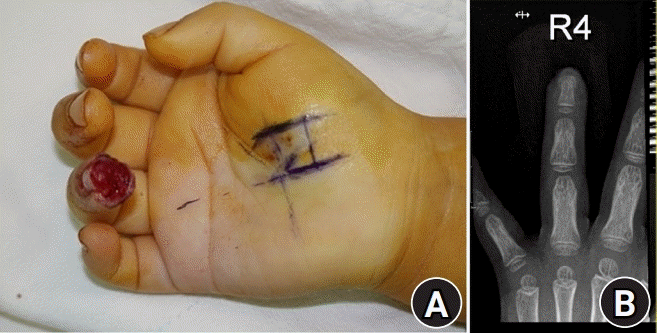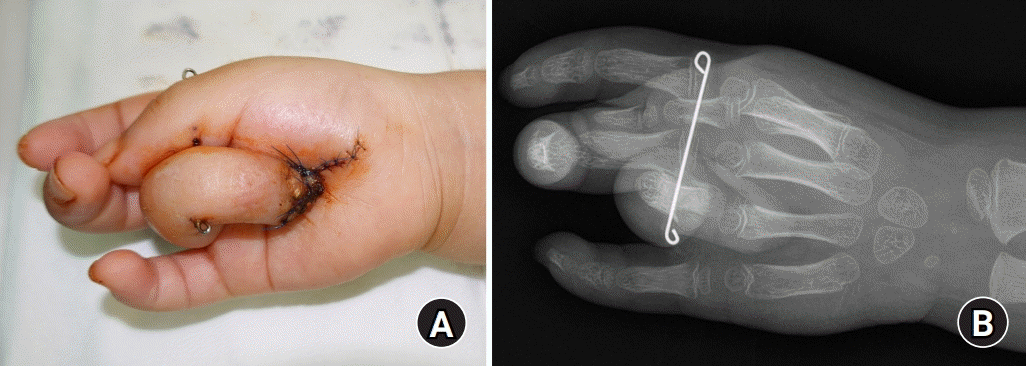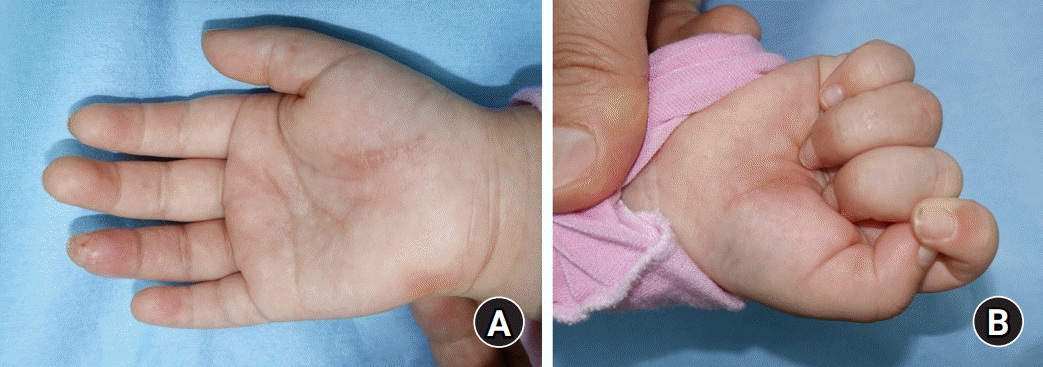Abstract
Thenar flap is a commonly used operational method in fingertip reconstruction. It should be maintained for 2 to 3 weeks before flap division until the neovascularization is established from the fingertip to the flap. However, immobilization between two stages of operation is challenging especially in uncooperative pediatric patients. A 47-month-old female with a ring fingertip amputation underwent soft tissue reconstruction with thenar flap. Two days postoperatively, the flap’s proximal margin was found disrupted. Flap revision was performed, followed by applying a transphalangeal Kirschner wire (K-wire) between the thumb proximal phalanx and ring finger middle phalanx. The flap was successfully divided two weeks after the original operation. The result was aesthetically pleasing, and no complication was observed, including dehiscence, necrosis, limitation of range of motion, and visible scar of the pinning sites. In conclusion, K-wire fixation is a safe and effective method to immobilize thenar flap in uncooperative pediatric patients.
Go to : 
Fingertip injuries are one of the most common types of hand trauma in pediatric patients [1]. Severe injuries involving substantial pulp loss often require soft tissue reconstruction to restore shape and preserve long-term functionality. Thenar flap, which was first described by Gatewood in 1926 [2], has been widely accepted as the workhorse flap for fingertip reconstruction. However, it requires two-staged operations including 2 to 3 weeks of interval period of immobilization. It is not easy to achieve and maintain immobilization especially in uncooperative pediatric patients. Some previous studies have suggested specific positions, taping or splinting techniques, but those methods are sometimes not sufficient enough to maintain the flap in an appropriate position in children [3-6]. Therefore, we introduce a new immobilization method by inserting a Kirschner wire (K-wire) between the injured finger and the thumb considering the opposite vectors of the two digits.
Go to : 
A 47-month-old female presented to the emergency department with a fingertip injury at her right ring finger after crushing it in the hinges of a chair. Written informed consent was obtained from the patient. The soft tissue defect included approximately one-fourth of the distal phalanx in length (Ishikawa zone 1), involving both the volar and dorsal side, with exposure of the distal tip of distal phalangeal bone (Fig. 1A). There was no disruption of tendon or neurovascular structures. A minor fracture line was observed in the distal phalangeal bone in the preoperative X-rays (Fig. 1B).
Because of the loss of the amputated part, the defect was covered by reconstruction with a 5×10 mm- sized, distally-based, fasciocutaneous thenar flap, elevated from the palmar thenar eminence (Fig. 2A). In the flap elevation, special care was taken to avoid injury to the palmar digital nerve of thumb. A long-arm, dorsal-blocking splint was applied postoperatively to prevent extension of the affected digit. The elbow was maintained in 90º flexion, and the metacarpophalangeal joint, proximal interphalangeal joint, and distal interphalangeal joint were all also flexed.
However, thenar flap’s proximal margin was found partially disrupted during ward dressing 2 days after the operation, and reoperation was planned (Fig. 2B). After repairing the dehisced flap inset margin, the ring finger middle phalanx was placed in close approximation to the thumb proximal phalanx opposite vectors. To avoid any injuries of the epiphyseal plates and neurovascular structures, midaxial lines were drawn first at the affected digit and thumb in a flexion state. Then, an 18-gauge catheter was carefully applied dorsal to the marked lines from the skin to the periosteum, and a 0.7 mm-sized K-wire was inserted through the catheter. The wire was inserted vertically towards the diaphysis’ longitudinal axes of the ring finger middle phalangeal bone and thumb proximal phalangeal bone to immobilize the flap (Fig. 3).
The position was sustained well for 2 weeks, and the flap was maintained in a healthy condition without any congestion or disruption. The K-wire was removed, and the flap’s distal margin was successfully divided 2 weeks after the first operation (Fig. 4). The donor site was closed by primary closure. The patient was satisfied with the aesthetic and functional outcome. There was no complication associated with the reconstruction with thenar flap, such as dehiscence, necrosis, and nail deformity. Further, no complication was observed regarding the insertion of a K-wire, including dermatitis, infection, visible scar, and contracture of the proximal interphalangeal joint of the affected finger.
Go to : 
Fingertip injuries are one of the most common types of hand trauma in pediatric patients [1]. Depending on the extent of injury, there are numerous surgical methods available, and each treatment option must be customized to the individual in order to restore the contour of fingertip and to preserve the sensation and range of motion with minimal donor site morbidity.
While small defects, that are less than 1 cm2 in area, are best treated by conservative secondary healing, moderate-sized defects require full-thickness skin grafts [7]. However, skin grafts can cause insufficient sensitivity, tenderness, and cold intolerance as long-term complications [8]. Local flaps are sometimes not sufficient to provide adequate coverage in young children with small hands. Atasoy volar V-Y advancement flaps are not suitable in cases with volar side oblique amputations [9], and Kutler bilateral advancement flaps produce inevitable scars in the midline which could cause scar pain [10]. Microvascular free tissue transfers are also not the practical treatment option for pediatric patients because of the prolonged operation time, risk of flap failure, donor site scar, and possible numbness [11].
Thenar flap has been accepted as the workhorse flap for fingertip reconstruction in injuries involving substantial pulp loss by many surgeons [12-14]. Thenar flap restores the bulk and contour of the fingertip with excellent tissue match by utilizing local autogenous tissue with minimal donor site morbidity. Even though the risk of proximal interphalangeal joint contracture has been mentioned in early studies, more recent studies have contradicted these concerns [4,13,14]. However, this method requires two-staged surgery and careful postoperative care for the thenar skin bridge between the two stages of operation, especially in undisciplined pediatric patients.
Some previous studies have described methods for stabilization of the thenar flap during the interval period. Flatt [3] suggested a specific postoperative position, in which all three joints of the affected finger lie in medium flexion posture to achieve maximum stabilization and circulation of the flap [3]. Melone et al. [4] advised to use a precisely fitted bulky dressing with application of tape strips to immobilize the carefully selected positioning of the affected digit [4]. Sano et al. [5] proposed immobilizing the operated finger with a dorsal splint in flexion status together with the other ulnar two digits. In this position, patients can relax the three ulnar digits equally and can feel less discomfort with immobilization. Gundes et al. [6] applied a butterfly-shaped splint over a bulky dressing to obtain immobilization and prevent flap detachment.
However, from our previous experience, these methods are not sufficient enough to prevent the slightest movement of pediatric patients that could result in tension, avulsion, and disruption of the flap. Therefore, we introduce a new method of immobilization of thenar flap by inserting a K-wire between the injured finger and the thumb considering the opposite vectors of the two digits. By confining the thumb and the affected finger in an absolutely immobilized posture, not only the affected digit but also the thumb cannot move at all, which supports the stabilization of the flap in the right location. Even though this posture might cause discomfort for the patient for not being able to grip with the thumb, we found no limitation of range of motion of the affected digit or the thumb after removing the K-wire in our case. The other possible complications regarding the insertion of a K-wire include infection, dermatitis, visible scar, and neurovascular injury, all of which did not occur.
To the best of our knowledge, this is the first report on the use of a K-wire in immobilization of the thenar flap. It is a simple, effective, and safe method, and it can be applied not only to the ring finger but also to the index finger or middle finger especially in uncooperative pediatric patients.
In conclusion, Kirshner wire fixation is a safe and effective method to immobilize thenar flap in uncooperative pediatric patients.
Go to : 
REFERENCES
1. Ljungberg E, Rosberg HE, Dahlin LB. Hand injuries in young children. J Hand Surg Br. 2003; 28:376–80.

2. Gatewood. A plastic repair of finger defects without hospitalization. JAMA. 1926; 87:1479.
4. Melone CP Jr, Beasley RW, Carstens JH Jr. The thenar flap: an analysis of its use in 150 cases. J Hand Surg Am. 1982; 7:291–7.
5. Sano K, Aoki S, Koike S, Hyakusoku H. Delayed extended “midthenar” flap for reconstruction of total fingertip avulsion injury and a proposal of ideal postoperative immobilization for a palmar flap. Ann Plast Surg. 2007; 58:116–9.

6. Gundes H, Tosun B, Buluc L, Alici T. Butterfly-type splint immobilization to prevent thenar flap detachment in children. Orthopedics. 2006; 29:495–6.

7. Hashem AM. Full-thickness grafting from the ulnar border of the palm: outcome and donor-site morbidity. Ann Plast Surg. 2011; 67:123–8.
8. Foucher G, Dallaserra M, Tilquin B, Lenoble E, Sammut D. The Hueston flap in reconstruction of fingertip skin loss: results in a series of 41 patients. J Hand Surg Am. 1994; 19:508–15.

9. Atasoy E, Ioakimidis E, Kasdan ML, Kutz JE, Kleinert HE. Reconstruction of the amputated finger tip with a triangular volar flap: a new surgical procedure. J Bone Joint Surg Am. 1970; 52:921–6.
11. Lee DC, Kim JS, Ki SH, Roh SY, Yang JW, Chung KC. Partial second toe pulp free flap for fingertip reconstruction. Plast Reconstr Surg. 2008; 121:899–907.

12. Fitoussi F, Ghorbani A, Jehanno P, Frajman JM, Penneçot GF. Thenar flap for severe finger tip injuries in children. J Hand Surg Br. 2004; 29:108–12.

13. Barr JS, Chu MW, Thanik V, Sharma S. Pediatric thenar flaps: a modified design, case series and review of the literature. J Pediatr Surg. 2014; 49:1433–8.

14. Weber DM, Kellenberger CJ, Meuli M. Conservative treatment of stable volar plate injuries of the proximal interphalangeal joint in children and adolescents: a prospective study. Pediatr Emerg Care. 2009; 25:547–9.
Go to : 




 PDF
PDF Citation
Citation Print
Print







 XML Download
XML Download